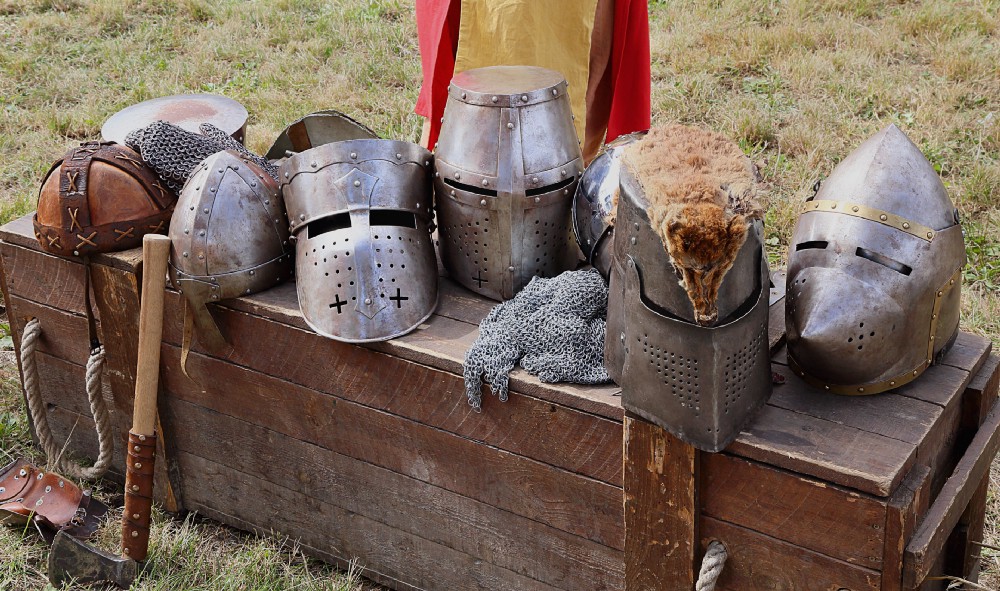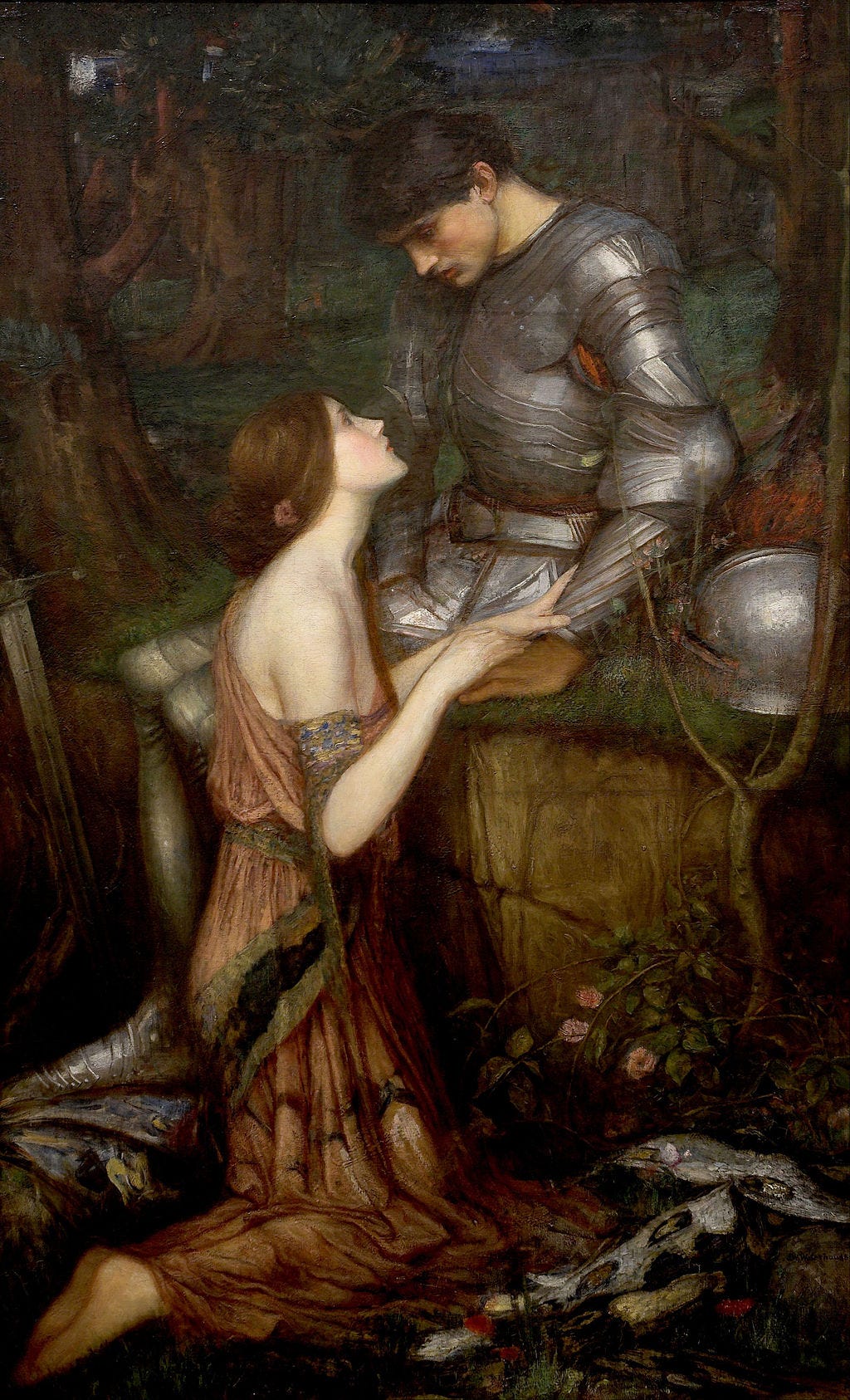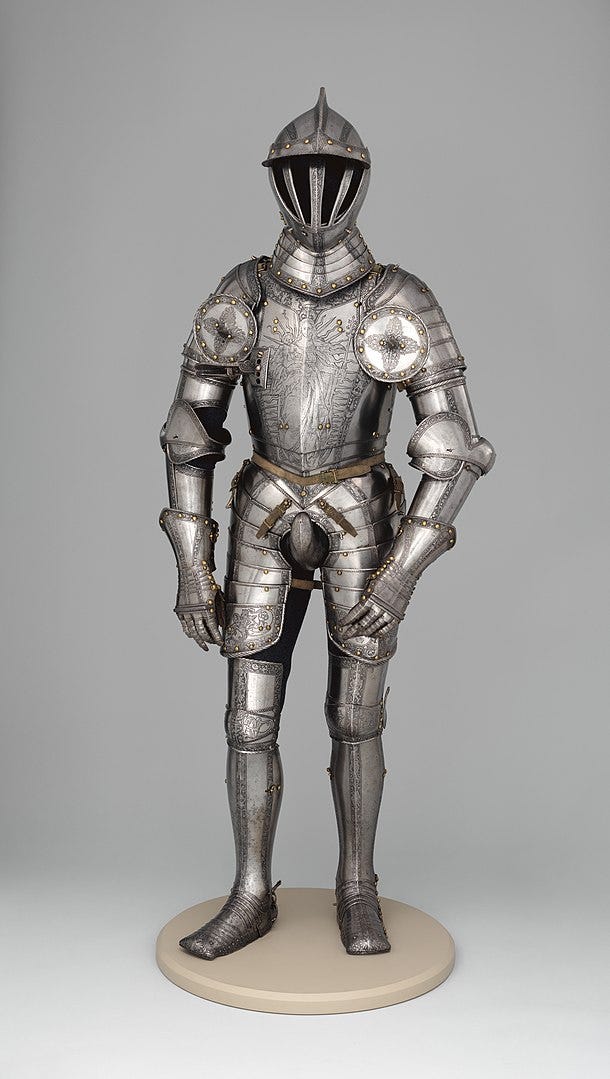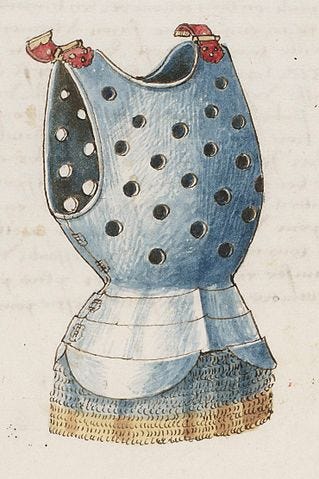How Cumbersome was Medieval Armor?

The knight in shining armor. Whatever you might think of his social skills, you’ve got to admit; wearing all that gear had to be a tough gig. I mean really, how does a guy manage in all that metal?
How does he move? And what happens when you’ve got to heed the call of nature? These are interesting questions, but before we dive into it, let’s talk about armor itself.
A little bit about armor
When you think of armor is there an image like this in your head?

This seems to be the stereotypical picture we all have. However, it took a while for full suits like this to come along. In the beginning, the basic pieces of armor included just a few items. Henry II of England declared in 1181:
“Let every holder of a knight’s fee have a hauberk, a helmet, a shield, and a lance.”
The hauberk was a long shirt of mail that either went to the elbow or down the length of the arm. So a shirt, helmet, and some accessories, that’s it.
A Knight’s mail didn’t come from the post office
Mail is small metal rings linked to form a mesh fabric. In the early days, they called it “ring maille.” Chain mail is actually an incorrect term because mail refers to an object made with interlocking rings. Saying chain mail, therefore, is redundant.
People began wearing mail in Europe around 300B.C. Its use was prominent from the early Middle Ages through the Renaissance, but it wasn’t until the 13th century that it started covering the entire body.
Usually, something was underneath, like a jacket of linen or felted wool. A blow to a shirt of mail would dissipate through ripples, like if you threw a stone into a lake.
According to the Royal Armoury at Leeds, it was difficult to penetrate with conventional medieval weapons. For close combat, heavy bruising and broken bones were the biggest problem. If the links were smashed, then you might have to deal with metal in your wounds and possibly blood poisoning.
Armor wasn’t just for knights
Armor similar to the one pictured above began gaining popularity in the 13th century, with its height being the 15th century.
For the record, it wasn’t an “exclusive right” of knights to wear armor. Archers, crossbowmen, peasants, and retainers could all wear it during battle. The difference came in the type, quality, and amount. Not all armor was made the same.
There was the second-hand thrift shop versions, the Macy’s versions, and the Bergdorf Goodman versions. You could buy some ready-made at fairs or markets, but the well to do had theirs tailored specifically to their body.
Then again, not all armor was metal. Cuir-bouilli, or boiled leather, was great for armor. The boiling process makes the leather malleable enough to be shaped.
When it cools, it’s about as tough as today’s high-impact plastics. Armor was never just one layer either, because the more layers you wear, the more protection you’ve got. So, even when plate became popular, guys were still wearing mail and fabric layers underneath.
Gambesons, or arming doublets were popular choices. They were jackets that had reinforced arming points where the plates were attached with laces. Some arming doublets even had mail built in to protect those vulnerable spots where the plate didn’t quite cover.
Obviously, being completely covered is the primary goal. Armor, therefore, was cut into pieces made to overlap, reinforcing the most important areas like the chest.
The other thing to remember is armor was never standard. It was a hodgepodge of what you could afford, what you were given, and sometimes what you won at the tournaments. So pieces that were out-of-date technology-wise would still be worn if its condition was good, and that was all you could manage.

How long did it take to get dressed?
Getting dressed in armor wasn’t the same as pulling on a pair of pants and a shirt. Instead, it was a process that could easily take around 20 minutes.
A guy started from his feet up. Think of it like puzzle pieces. Everything had to match up properly. Ties, leather straps, and buckles kept things nice and tight. So tight in fact that in good armor you wouldn’t even be able to slip a piece of paper between the plates.
A guy might arm his legs just fine on his own, but the further up he went the harder it would become. In reality, he probably didn’t lift a finger. He had a squire or page to do it all for him.
If he had two, it went even faster. Good planning was certainly a necessity. If your enemy caught you off guard, there was no quick donning of armor. There were just too many pieces in a full suit.
Was armor super heavy?
A guy armed for battle in a complete suit would carry about 44-55 pounds.To compare, firefighters can wear between 45 and 75 pounds, while modern military armor can be as low as 20 and up to 100 with all the extras.
The difference lies in the distribution of weight. Modern equipment focuses the bulk of the burden on the shoulders and waist. By contrast, medieval armor distributed it across the whole body.
The legs, for example, had sabatons on the feet, greaves on the lower leg, poleyns over the knees, cuisses, and tassets for the thighs — so lots of pieces being attached. Remember, things needed to overlap, and the more layers, the more weight. Still, in life or death situations whose going to complain about weight?
And speaking of life or death . . .
How well could a guy move in armor?
The answer is exceptionally well. Sure, some early armor may not have been as flexible, but let’s face it; if a guy can’t move he can’t fight, and if he can’t fight, he can’t win and if he can’t win, well you know where this is going.
It would be the definition of insanity to keep wearing something that made you a sitting duck. So just get rid of any images in your head of knights flat on their back screaming I’ve fallen and I can’t get up.
As far as not being able to get on a horse unassisted, books and movies popularized that theory. Laurence Olivier ran with the idea a guy had to be hoisted into his saddle with a crane in his 1944 movie Henry V.
Historians went nuts, but he thought it made the scene way cooler. Illustrations from the period, however, show armored men mounting horses with ease. No cranes or ladders required. The exception here is armor made specifically for the pageantry of the joust. This type could be heavier and much more cumbersome. No one would really battle in it though.
Was it uncomfortable?
Although a guy could make whatever movements necessary in his armor, he would not lounge in it like in the Waterhouse painting above.
It would be like modern army guys lying about in their Kevlar. The short of it is Waterhouse and his Pre Raphaelite contemporaries were romantics enamored with the medieval period. Damsels and knights just made darn good paintings.
The University of Leeds put a few re-enactors in replica armor, stuck them on a treadmill, and monitored their oxygen consumption and breathing rates. They concluded the armor made running 1.9 times more difficult and walking 2.3 times tougher than normal.
On top of that, breathing was more difficult because the metal plates hindered the chest muscles that would normally help with breathing. The result was faster, shallower breaths. Then there’s the heat.
All that fighting is going to cause a guy to sweat, but there aren’t many escape routes for heat and perspiration. Things could get very hot, and dehydration was certainly a concern.
Helmets would only add to the discomfort. Openings could be very small, making it difficult for heat to escape and fresh air to come in. A guy could cool down some if he took his helmet off, but that’s not an option in the midst of battle.
Then, of course, vision can be impaired. Kind of a horse with blinders syndrome. If you wanted to see to the side, you would need to turn your head. As far as hearing, things were certainly going to be a bit muffled so, you’d have to shout to communicate with your fellow knights.
With all those pieces, how did a guy go?

Suits of armor didn’t have metal plates covering the crotch or tushie mostly because a knight had to sit on his horse. Instead, they wore quilted cotton leggings and mail. On top of these were metal skirt like pieces.
The armor plates on the front of the skirt were called faulds, and when on the tooshie, it was a culet. They also attached the leg plates to the torso plate or to a belt, so that might complicate matters.
When a guy had to skip to the loo then, he would need help from his squire to unbuckle and remove anything getting in the way of the necessary exit points.
Wanna geek-out on armor history?
This is one of those topics that you could research forever. Armor was not universal, it was different depending on the time and place and the size of your wallet. There’s lots of impressive stuff on the web, but I’ll leave you with these links to some great YouTube videos.
Open Culture has this great two-part demonstration on making and wearing medieval armor.
Here’s a montage of clips demonstrating mobility in plate armor.
Finally, check out everything by Jason Kingsley. This 55-year-old British CEO likes to spend his free time being a medieval knight. This video here is about wearing armor.
Are you an armor wearer?
I know you’re out there, you LARPers and re-enactors. Why not share your experiences in the comments!
Notes and Sources:
If you want to be technical, an arming doublet was not the same as a gambeson. Arming doublets were specifically for use under armor and would not have been as thick. Gambesons were their thicker counterparts meant to be stand-alone armor.
https://www.historyextra.com/period/medieval/how-did-knights-in-armour-go-to-the-toilet/
https://digitalcommons.wpi.edu/cgi/viewcontent.cgi?article=2692&context=iqp-all
https://www.ukessays.com/essays/history/the-history-of-chain-mail-history-essay.php
https://www.metmuseum.org/toah/hd/aams/hd_aams.htm
https://digitalcommons.wpi.edu/cgi/viewcontent.cgi?article=2692&context=iqp-all
Related Posts
The Days When Fashion Was Only for the Rich
In today’s world, the only thing that limits what you wear is the…
October 1, 2020Was Robin Hood Just a Story or Was He Real?
Robin Hood. It’s a name that immediately conjures up that spritely outlaw fighting…
June 5, 2020



Leave A Comment